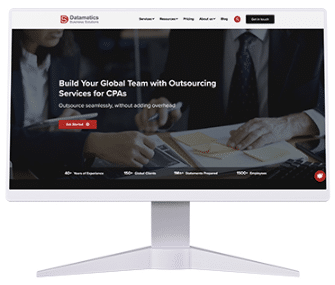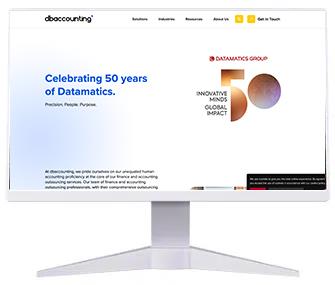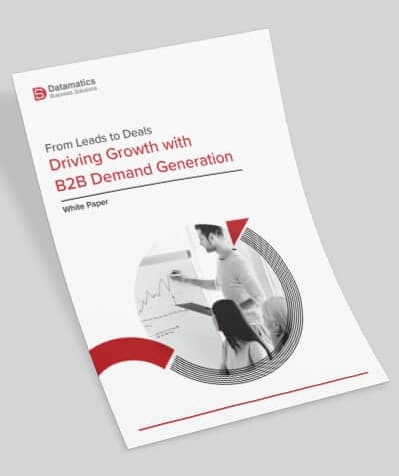The world of B2B demand generation is experiencing a seismic upheaval. The demand engines of old are now powered by Artificial Intelligence (AI) and are thus much more capable and powerful. The modern marketing leaders are harnessing the power of advanced AI to build demand engines that are agile, responsive, and customer-centric. Industry leaders across the United States are already refining their go-to-market strategies for the AI-first industry of tomorrow.
As the marketing landscape continues to evolve, it will be the adoption of AI that differentiates the businesses that will thrive in the modern market from those that will be left behind. To delve deeper into the issue, we recently sat down with two industry veterans, Peter Murphy, CEO of Datamatics Business Solutions, and Krishnan Chatterjee, Head of Marketing at Google Cloud India, for an insightful podcast on “how B2B organizations are modernizing their demand engines for sustained growth and customer relevance” leveraging the power of advanced artificial intelligence.
This blog encapsulates the hour-long discussion highlighting the key lessons for marketers to take away and perhaps implement as part of their organization’s growth plan. If you are B2B marketer looking to modernize your demand engine with AI, here is everything you need to know.
Redefining Customer-Centric Demand Engines
The traditional demand engines currently part of our marketing ecosystems are highly fragmented across brands, events, and disjointed campaigns. These engines no longer meet the requirements of modern marketers. In today’s market, customers demand personalized, real-time engagement that identifies and addresses their challenges.
During the discussion, Krishnan emphasized building B2B demand engines around three core capabilities:
User-centricity
The demand engine of today must centre on every buyer’s problem and preference. AI can then be leveraged to add a layer of personalization.
Real-World Context
If you are building a demand engine for today, it must utilize real, actionable customer data to drive engagement strategies and messaging.
Real-Time Responsiveness
Your demand engine must have the ability to adapt to market shifts and buyer signals, harnessing the power of AI-driven analytics.
Trusted Data
Your demand engine must build credibility and security into every interaction to meet the needs of modern B2B buyers.
By building your demand engine around these pillars, you ensure that your demand generation initiatives are not disjointed efforts but are an integrated, strategic function at the heart of business value creation.
The AI Shift: How Leaders See the Opportunity
We are far away from the time when AI was considered merely a technological experiment. For industry leaders, AI is the infrastructure of today. During the podcast, Peter underlined that the B2B marketers of today need “a new backbone for how we gather insights, design campaigns, and measure performance.”
Adding to Peter’s comment, Krishnan mentioned that “AI is now powerful enough to help companies tackle the age-old challenges: fragmented data, misaligned sales and marketing, stale ICPs, and low conversion efficiency.”
Based on comments made by both the leaders, it is easy to understand that in the market of tomorrow, winners will be those who:
- Consider AI as a strategic layer that spans people, processes, and platforms.
- Have an active data hygiene plan.
- Stay realistic: AI is not here to replace human judgment; it is here to replace it.
The bottom line? Businesses that actively adapt AI to revolutionize their demand engines are the ones that will unlock new avenues of revenue, grow more quickly, and outpace competitors who are still relying on manual methods.
Core Areas Where AI Powers B2B Demand Generation
There is ample evidence of AI making a difference in the business world by streamlining business decisions and delivering unmatched levels of accuracy. For the blog, we will highlight the four biggest levers where we believe AI is already driving concrete impact.
Audience Targeting
The traditional marketing methods for audience targeting largely depend on static firmographic and demographic data. However, by incorporating AI into the process, you now receive signals from multiple touchpoints — including the website, intent data, purchase patterns, and social media interactions — for refining Ideal Customer Profiles (ICPs) dynamically.
During the discussion, Peter highlighted how one global SaaS company used AI models to score fit and intent in real-time, re-prioritizing target accounts daily. This resulted in a 32% increase in pipeline velocity within just one quarter.
So, if you are going for audience targeting, make sure to use AI to constantly tweak your targeting based on intent signals that truly correlate with conversions, and then adjust your outreach accordingly.
Hyper-Personalized Engagement
There still are marketing functions that depend on “spray-and-pray email blasts.” Yours does not have to be one of them. AI helps B2B marketers to create personalized user journeys at scale by analyzing prospect interests, content interactions, and buying stage.
Krishnan highlighted a B2B marketplace that plugs AI into its CRM and content engine. The AI then nurtures and tailors the path for each member of the buying group, suggesting the relevant webinar, product sheet, or case study at precisely the right moment. The result? 50% improvement in engagement from C-level decision makers.
So, as a marketer, you must consider personalization as a pipeline multiplier, not just a feel-good tactic. AI can also help you easily maintain relevance across thousands of accounts, 24/7.
Predictive Lead Scoring and Routing
Enterprises worldwide have been utilizing AI-driven lead scoring; however, too many of them underutilize it. When done correctly, predictive lead scoring can help you identify accounts and contacts that are sales-ready, saving both time and resources for your organization.
Peter highlighted how a fintech firm layered their AI-powered lead scoring on top of traditional MQL definitions by combining behavioural signals with third-party intent and historical deal data. As a result, they were able to elevate their sales win rate by as much as 18% simply by focusing their efforts where they had the highest yield.
Therefore, you should not consider lead scoring static; instead, you need to tune your models frequently and integrate AI scoring directly into your CRM workflows.
Content Intelligence at Scale
Content is still the fuel that powers the B2B demand engine; however, creating engaging, unique, and creative content that resonates with your target audience is challenging. The good news is that AI can help you overcome this bottleneck by:
- AI can help you establish the format that resonates best with your audience.
- Help you identify new topics based on search trends and buyer questions.
- Automating content repurposing for different channels.
During the discussion, Krishnan mentioned a software company that utilized generative AI to adapt long-form whitepapers into bite-sized ads, sales enablement snippets, and social posts — all aligned to the same theme but customized for each audience.
Although you must not wholly rely on AI for your content requirements, it certainly can help you amplify your human efforts.
What is Next? Where Do We Go from Here?
At the end of the hour-long discussion, Peter and Krishnan unanimously agreed on three significant trends that will shape tomorrow’s demand engines:
Increasing Use of Generative AI in Campaign Execution
While it is currently primarily used for generating content, Generative AI can also be utilized for handling a wider range of tasks, from drafting personalized emails to recommending next-best actions for sales personnel.
AI-Powered Buying Group Orchestration
In the B2B world, buying groups drive the buying decision, not individuals. With advancements in AI, we will be able to map these buying groups better, identifying key influencers and suggesting multi-threaded engagement paths.
Always-On Revenue Operations
The revenue engines, too, will evolve into AI-powered engines with the capability to tweak budgets, reallocate spend, and adjust target segments in near real-time, based on what is converting today, not last quarter.
Businesses that are looking to get future-ready and not relying heavily on what is in front of them today have already started harnessing the power of AI for their demand engines; it is time for you to do the same. If you need help getting started with AI-powered demand engines, please write to us at marketing@datamaticsbpm.com, and we will have our demand generation experts reach out to you with a solution tailored to your business needs.

Paul van de Kamp



